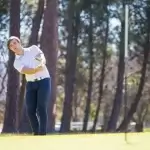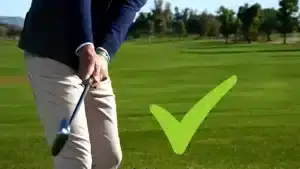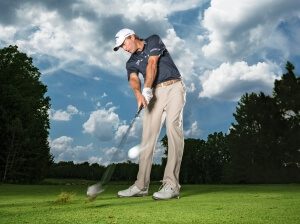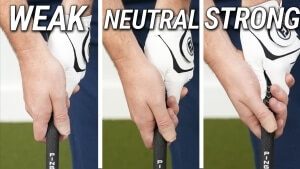Are you an avid golfer who struggles with a frustrating slice? If so, you’re not alone. The slice is a common problem that plagues many golfers, from beginners to seasoned pros. But fear not, because in this article, we will explore various techniques and tips to help you fix that pesky slice and improve your game.
A slice occurs when the ball curves excessively from left to right (for right-handed golfers) or right to left (for left-handed golfers). It often results in a loss of distance and accuracy, making it one of the most frustrating issues to overcome on the golf course.
In this comprehensive guide, we will delve into the root causes of a slice and provide you with step-by-step instructions on how to correct it. We will discuss the importance of a proper grip, body alignment, and swing path, as well as the role of your clubface at impact. By understanding these key elements and making the necessary adjustments, you’ll be well on your way to hitting straighter shots and enjoying the game even more.
But that’s not all. We will also touch on common misconceptions about fixing a slice and debunk some prevailing myths. Additionally, we will explore the benefits of seeking professional instruction or using training aids to accelerate your progress.
Whether you’re a beginner looking to develop a solid foundation or a seasoned golfer aiming to fine-tune your skills, this article will provide you with the knowledge and tools to fix your slice once and for all. So, grab your clubs, get ready to dive into the world of golf mechanics, and let’s start fixing that slice together.
Remember, this is just the beginning of our journey towards a better golf game. Stay tuned for the in-depth discussions and practical tips that lie ahead.
What Causes a Slice?
A slice is a common problem that many golfers face. It occurs when the golf ball curves to the right (for right-handed golfers) or to the left (for left-handed golfers) excessively. This can be frustrating and can significantly affect your game. But what causes a slice?
One of the main causes of a slice is an open clubface at impact. When the clubface is open, it means that the face of the club is pointing to the right (for right-handed golfers) or to the left (for left-handed golfers) of the target. This causes the ball to spin in that direction, resulting in a slice.
Another cause of a slice is an out-to-in swing path. This means that the club is coming from outside the target line and cutting across the ball at impact. This also leads to a side spin on the ball, causing it to slice.
Furthermore, a weak grip can contribute to a slice. When your grip is too weak, it means that your hands are rotated too far to the left (for right-handed golfers) or to the right (for left-handed golfers). This makes it difficult to square the clubface at impact and can result in a slice.
Lastly, an improper weight transfer can also cause a slice. If your weight is not shifting correctly during your swing, it can lead to an open clubface and an out-to-in swing path, both of which contribute to a slice.
In conclusion, understanding the causes of a slice is crucial in fixing this issue. By addressing factors such as an open clubface, an out-to-in swing path, a weak grip, and improper weight transfer, you can start to correct your slice and improve your golf game. Stay tuned for our next article, where we will discuss effective strategies to fix a slice.
How to Grip the Club Correctly
Having the correct grip on your golf club is essential for improving your swing and fixing that pesky slice. A proper grip allows you to have better control over the clubface, leading to straighter shots and more consistency on the course. In this article, we will guide you through the steps of gripping the club correctly to help you fix your slice and improve your overall game.
To start, place the club in your left hand (for right-handed golfers) and position it diagonally across your fingers. The club should rest just below the pad of your left hand. Make sure your thumb is pointing straight down the shaft. This neutral grip will help you square the clubface at impact, reducing the chance of slicing.
Next, place your right hand on the club, making sure your left thumb fits snugly into the lifeline of your right hand. This overlapping grip, also known as the Vardon grip, provides stability and control throughout your swing. Your right pinky finger should rest between the index and middle fingers of your left hand, creating a secure connection between both hands.
As you grip the club, ensure that your hands work together as one unit. Avoid gripping too tightly, as this can restrict your wrist movement and lead to a slice. Instead, maintain a relaxed grip pressure that allows for a smooth and fluid swing.
Remember, the correct grip is just one aspect of fixing a slice. It is important to also work on your swing path, body alignment, and weight transfer to fully correct the issue. Practice regularly and seek guidance from a golf professional to refine your technique and improve your game.
By following these steps and adopting the proper grip, you will be on your way to fixing your slice and hitting more accurate shots on the golf course. Keep practicing and enjoy the journey to becoming a better golfer.
How to Align Your Body Properly
Do you struggle with your golf swing? Are you constantly battling a slice that sends your ball veering off to the right? Don’t worry, you’re not alone. Many golfers face this common problem, but the good news is that there are steps you can take to fix it.
One of the key factors in fixing a slice is aligning your body properly. When your body is aligned correctly, it allows you to swing the club on the correct path, resulting in straighter shots. So, how do you align your body properly?
First, start by checking your stance. Your feet should be shoulder-width apart, with your weight evenly distributed between them. Make sure your knees are slightly flexed and your spine is straight. This will help you maintain balance throughout your swing.
Next, focus on your hips and shoulders. They should be parallel to your target line. Many golfers make the mistake of opening their hips and shoulders too much, which can lead to a slice. Keep them square to the target and you’ll be on the right track.
Another important aspect of alignment is your grip. Make sure your hands are positioned correctly on the club, with your left hand (for right-handed golfers) slightly rotated to the right. This will help you square the clubface at impact, reducing the chances of a slice.
Lastly, pay attention to your aim. Your clubface should be square to your target at address. Use a target line or an intermediate target to help guide your aim. This will ensure that you’re starting your swing on the right path.
By aligning your body properly, you’ll be able to fix that pesky slice and start hitting straighter shots. Practice these alignment tips regularly and watch your game improve. Remember, consistency is key, so be patient and keep working on your alignment. Good luck!
How to Fix an Over-the-Top Swing
Having an over-the-top swing can be frustrating for any golfer. It often leads to a slice, causing the ball to curve uncontrollably to the right (for right-handed golfers). But fear not, as there are ways to fix this common swing flaw and improve your game.
One of the main causes of an over-the-top swing is an improper sequencing of the body and arms during the downswing. To fix this, focus on starting the downswing with your lower body. Shift your weight onto your front foot and rotate your hips towards the target. This will help you initiate the downswing from the inside, preventing the over-the-top motion.
Another key aspect to address is the position of your club at the top of the backswing. If your club is too far outside the target line, it’s likely to result in an over-the-top swing. To correct this, work on keeping your club on a more neutral path during the backswing. Practice taking the club back along the target line and maintaining a square clubface.
Furthermore, it’s essential to develop a proper grip and hand position. A weak grip can contribute to an over-the-top swing, so ensure your grip is firm but not too tight. Additionally, focus on keeping your hands in front of the clubhead throughout the swing to promote a more inside-out path.
Lastly, be mindful of your body rotation and balance. A lack of rotation or poor balance can lead to an over-the-top swing. Practice exercises that improve your flexibility and strengthen your core muscles. This will help you maintain a stable base and execute a more fluid swing.
In conclusion, fixing an over-the-top swing requires addressing various aspects of your technique, including body sequencing, club path, grip, and balance. By implementing these tips into your practice routine, you’ll be on your way to straighter shots and a more consistent golf game.
How to Rotate Your Hips Correctly
Rotating your hips correctly is crucial for golfers looking to fix their slice. By mastering this fundamental movement, you can improve your swing and achieve greater accuracy and distance off the tee. In this article, we will guide you through the steps to rotate your hips correctly and eliminate that frustrating slice from your game.
To begin, it’s important to understand the role of the hips in the golf swing. The hips act as the engine of your swing, generating power and providing stability. When you rotate your hips correctly, you create a strong foundation for your swing and promote a proper sequencing of movements.
To rotate your hips correctly, start by addressing the ball with a shoulder-width stance. As you initiate your backswing, focus on turning your back hip away from the target. This movement should feel like you are coiling your upper body against a stable lower body. Avoid swaying or sliding your hips laterally, as this can lead to an open clubface and a slice.
As you transition into the downswing, initiate the movement with your lower body. This means starting the rotation of your hips before your arms and clubhead. This sequencing of movements allows you to generate power from the ground up and promotes a more inside-out swing path, which helps to eliminate the slice.
During the follow-through, continue rotating your hips towards the target. This movement should feel natural and fluid, allowing your body to release the club through impact. Remember to maintain a balanced finish position, with your weight evenly distributed on your front foot.
In conclusion, mastering the correct rotation of your hips is essential for fixing a slice in your golf swing. By following the steps outlined in this article, you can improve your swing mechanics and achieve greater accuracy and consistency on the course. Practice these techniques regularly, and you’ll be on your way to a slice-free game.
How to Release the Club at Impact
When it comes to fixing a slice in your golf swing, one crucial aspect to focus on is the release of the club at impact. The way you release the club can greatly influence the direction and shape of your shots. In this article, we will delve into the key techniques and tips to help you improve your club release and ultimately fix that pesky slice.
One of the most common mistakes golfers make is holding onto the club too tightly throughout the swing. This tight grip restricts the natural release of the club, leading to an open clubface at impact and a slice. To release the club properly, focus on maintaining a relaxed grip, allowing your wrists to naturally hinge and unhinge during the swing.
Another important factor in releasing the club is the position of your hands at impact. Aim to have your hands slightly ahead of the clubhead at the moment of impact. This forward shaft lean helps to square the clubface and promotes a straighter ball flight. Practice this by rehearsing impact positions and gradually incorporating it into your full swings.
Weight transfer is also crucial for a proper club release. As you swing through the ball, shift your weight from your back foot to your front foot, ensuring that your body rotates through the shot. This transfer of weight helps to generate power and allows for a smooth release of the club.
Lastly, practice is key to improving your club release. Spend time on the driving range, focusing on these techniques and gradually incorporating them into your swing. Film your swing or seek feedback from a golf professional to identify any flaws in your release and make necessary adjustments.
By mastering the art of releasing the club at impact, you can effectively fix your slice and enjoy more accurate and consistent shots on the golf course. Remember, it takes time and practice, but with dedication, you can become a better player.
How to Practice Drills to Fix a Slice
Are you frustrated with your golf swing because it consistently produces a slice? Don’t worry, you’re not alone. Many golfers struggle with this common issue, but the good news is that there are drills you can practice to fix it. In this article, we will explore some effective drills that can help you eliminate that dreaded slice from your game.
One drill that can be beneficial is the alignment drill. To do this drill, place two alignment sticks or clubs on the ground parallel to your target line. Position one stick just outside your ball and the other about 12 inches to the right. This will help you visualize the correct swing path and prevent you from coming over the top, which often leads to a slice.
Another useful drill is the inside-out drill. Start by placing a tee in the ground about two feet in front of your ball. The goal is to swing the clubhead from the inside and hit the tee. This drill promotes an inside-out swing path, which can help you avoid slicing the ball.
Weight transfer is also crucial in fixing a slice. One drill that can improve your weight transfer is the step-through drill. Begin by taking your normal setup and then take a small step forward with your lead foot as you start your downswing. This drill encourages proper weight transfer and can help you achieve a more consistent ball flight.
In conclusion, practicing these drills can be instrumental in fixing a slice. By incorporating alignment, inside-out, and weight transfer drills into your practice routine, you can make significant improvements in your swing and ultimately eliminate that frustrating slice from your game. So, grab your clubs, head to the driving range, and start practicing these drills to see the results for yourself.
How to Maintain a Square Clubface at Impact
In the world of golf, one of the most frustrating shots to deal with is the slice. It’s a shot that veers off to the right for right-handed golfers, or to the left for left-handed golfers. But fear not, there are ways to fix a slice and improve your game. One key aspect to focus on is maintaining a square clubface at impact.
To understand how to maintain a square clubface at impact, it’s important to first grasp the concept of the clubface angle. The clubface angle refers to the direction the clubface is pointing at impact. If the clubface is open, it will result in a slice. To prevent this, you need to ensure that the clubface is square at impact.
One technique to help maintain a square clubface at impact is to work on your grip. Make sure your grip is neutral, with the “V” formed by your thumb and index finger pointing towards your right shoulder (for right-handed golfers). This will help square the clubface at impact and reduce the chances of a slice.
Additionally, focusing on your swing path can also make a difference. A swing that comes from outside the target line can lead to an open clubface at impact. Instead, try to swing from the inside, with the clubhead approaching the ball from behind the target line. This will help promote a square clubface at impact and minimize the chances of a slice.
Lastly, practicing with alignment aids can be beneficial. These aids can help you visualize and align your clubface properly at impact. Utilize alignment sticks or even a simple golf towel placed on the ground to ensure your clubface is square to the target.
By focusing on maintaining a square clubface at impact through proper grip, swing path, and alignment, you can effectively fix a slice and improve your golf game. Remember, consistency is key, so practice these techniques regularly to see lasting results on the course.
In conclusion, fixing a slice in your golf game is crucial for improving your overall performance on the course. Throughout this post, we have covered various topics that are essential in addressing this issue.
Firstly, we discussed the causes of a slice. Understanding the root of the problem is the first step towards fixing it. We then delved into the correct grip and alignment, emphasizing the importance of a proper setup to promote a square clubface at impact.
Next, we explored how to fix an over-the-top swing, a common mistake that leads to slicing. By implementing the correct swing path and focusing on rotating the hips correctly, you can greatly reduce the chances of slicing the ball.
Additionally, we discussed the crucial role of releasing the club at impact. Mastering this technique allows for a more controlled and accurate shot, preventing the dreaded slice. We also provided various practice drills to help you develop muscle memory and improve your swing.
Maintaining a square clubface at impact is vital in preventing a slice. We explained the significance of this aspect and provided tips on how to achieve it consistently.
As we conclude, it is important to stress the significance of the keyword “how to fix a slice.” By implementing the techniques and advice discussed in this post, you can significantly improve your golf game and lower your scores.
Looking ahead, the world of golf is constantly evolving, and new developments and trends may impact the techniques used to fix a slice. It is important to stay updated and adapt to any changes in the game.
Thank you for taking the time to read this post. We hope you found the information valuable and actionable. We encourage you to leave any comments or feedback, as your input is greatly appreciated. Remember, with dedication and practice, you can conquer the slice and elevate your golfing skills.




